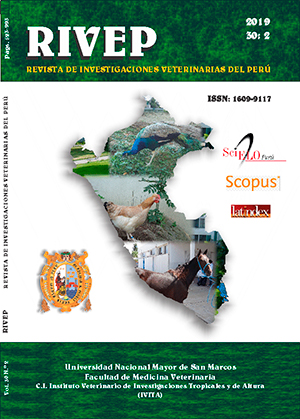Analysis of the antibody titre in sows vaccinated against classical swine fever at four gestation ages
DOI:
https://doi.org/10.15381/rivep.v30i2.15143Keywords:
classical swine fever, classical swine fever virus, blocking ELISA, EcuadorAbstract
The immune response acquired by vaccination against classical swine fever (CSF) in sows at four gestational ages (70, 75, 80 and 90 days) was evaluated using the Pest-Vac® vaccine (Pfizer). Blood samples were taken 24 hours before vaccination and 72 hours after parturition. The level of antibodies was determined by a blocking ELISA. No significant difference was found between the antibody titres generated by the vaccination according to gestational age nor between the pre-vaccination and post-partum samples. However, the effect of the number of parturitions, used as a covariate, presented a significant difference (p<0.05) in the percentage of blocking of antibodies against PPC.
Downloads
Downloads
Published
Issue
Section
License
Copyright (c) 2019 Jacqueline Noboa

This work is licensed under a Creative Commons Attribution-NonCommercial-ShareAlike 4.0 International License.
AUTHORS RETAIN THEIR RIGHTS:
a. Authors retain their trade mark rights and patent, and also on any process or procedure described in the article.
b. Authors retain their right to share, copy, distribute, perform and publicly communicate their article (eg, to place their article in an institutional repository or publish it in a book), with an acknowledgment of its initial publication in the Revista de Investigaciones Veterinarias del Perú (RIVEP).
c. Authors retain theirs right to make a subsequent publication of their work, to use the article or any part thereof (eg a compilation of his papers, lecture notes, thesis, or a book), always indicating the source of publication (the originator of the work, journal, volume, number and date).










